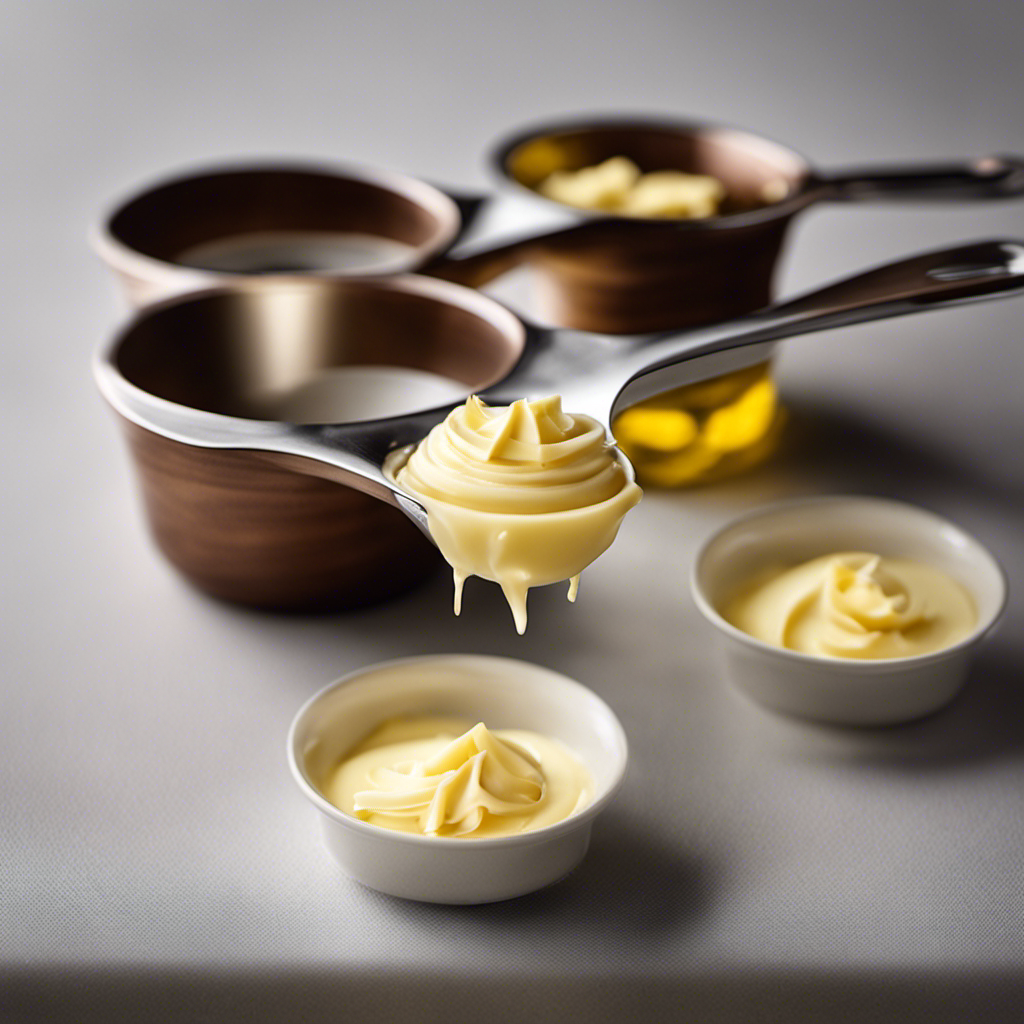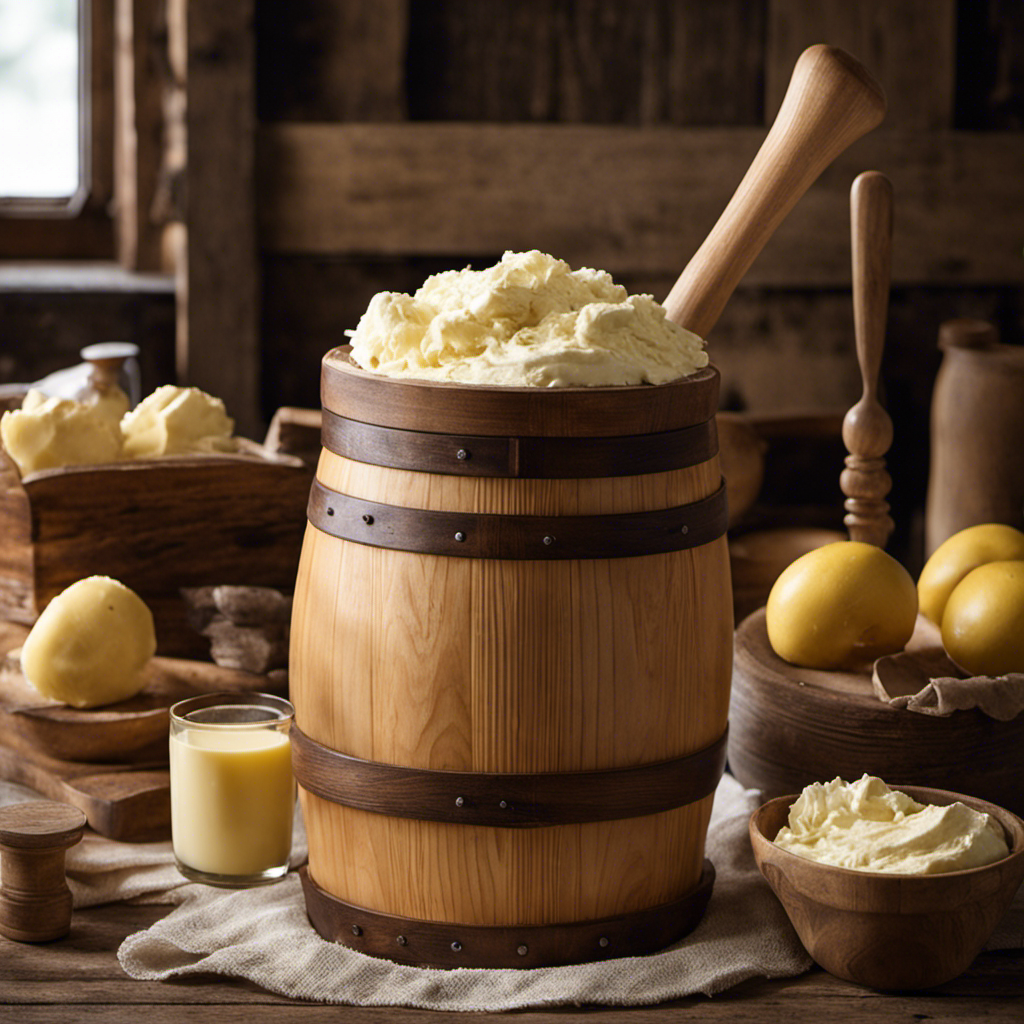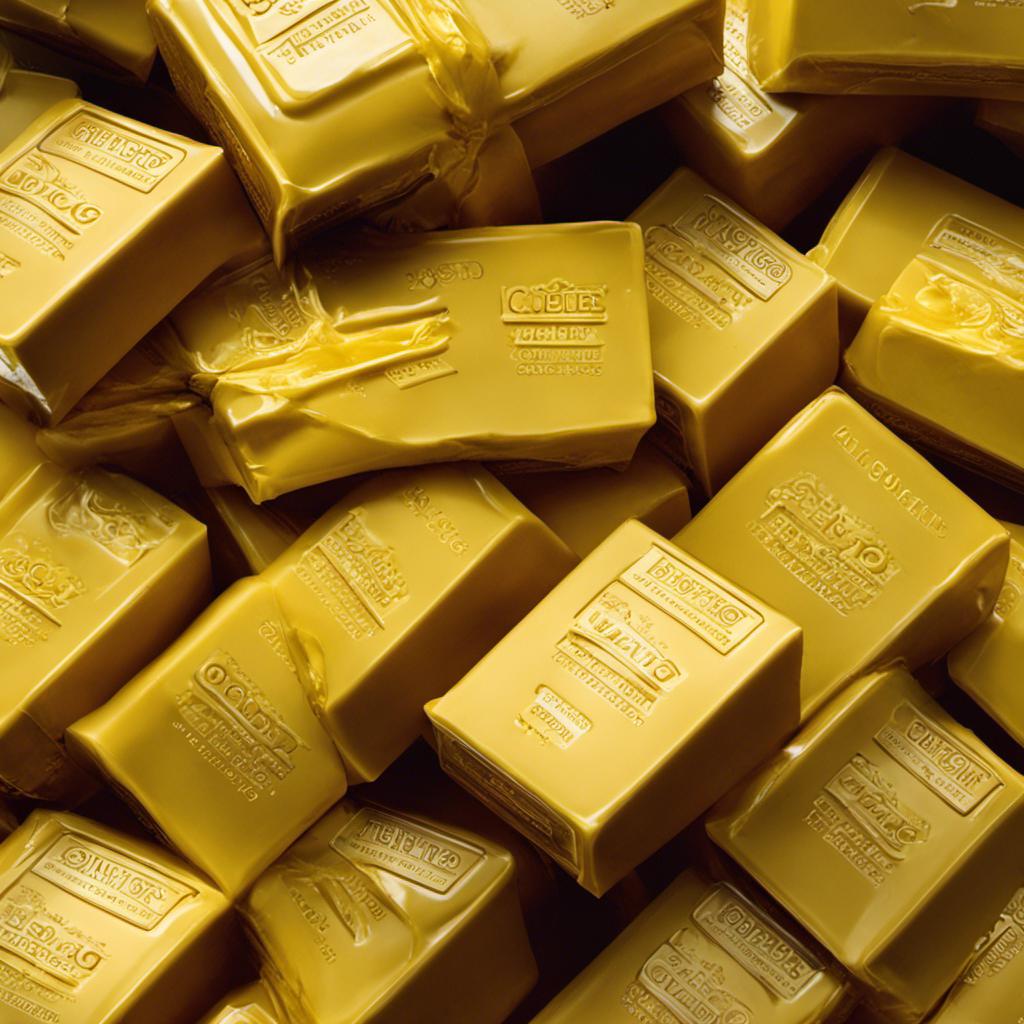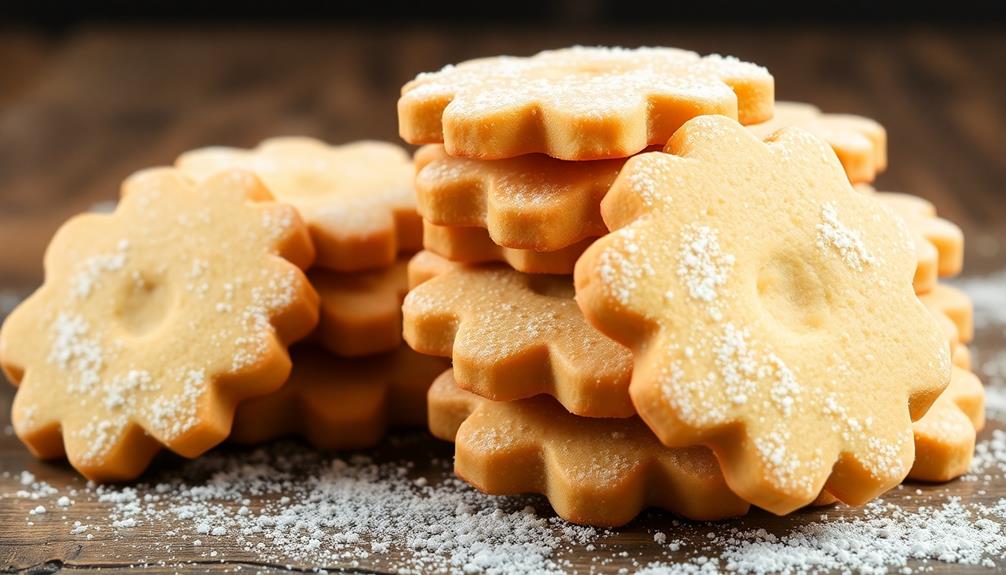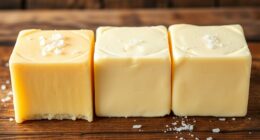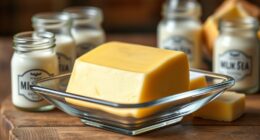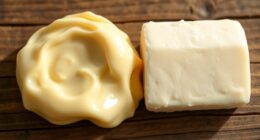The conversion rate between butter and oil in cooking recipes has always intrigued me. It’s interesting to see how such a straightforward switch can entirely alter a dish’s texture and taste.
In this article, we’ll delve into the science behind this conversion and explore why using butter instead of oil can be a game-changer.
I’ll also share tips on calculating the amount of butter needed and achieving the same delicious outcome.
Get ready to elevate your cooking skills with this buttery knowledge.
Key Takeaways
- 1/2 cup of oil can generally be substituted with 1/2 cup plus 1 tablespoon of butter.
- Converting measurements is essential when substituting butter for oil.
- Different types of butter and oil have varying flavors and textures.
- It is recommended to experiment and adjust the ratio based on personal preference and desired outcome.
Butter and Oil: Understanding the Conversion Ratio
To understand the conversion ratio between butter and oil, you need to know how much butter equals 1/2 cup of oil.
When it comes to cooking techniques, comparing butter and oil can be helpful. Butter adds a rich flavor and a creamy texture to dishes, while oil is known for its ability to evenly distribute heat and create a crispier texture.
However, when it comes to health considerations, choosing between butter and oil in recipes is important. Butter is high in saturated fat, which can increase the risk of heart disease. On the other hand, oils like olive oil and avocado oil are rich in healthy fats and can be a better choice for those looking for a healthier option.
It is always advisable to consider both the taste and health aspect when deciding between butter and oil in your recipes.
Why Use Butter Instead of Oil
When it comes to culinary choices, butter’s rich flavor and creamy texture make it a standout ingredient. Its distinct taste adds depth and complexity to dishes, elevating the overall dining experience.
Additionally, its creamy texture lends itself well to various cooking methods, allowing for easy incorporation and smooth distribution throughout the recipe.
In this discussion, we will explore the reasons behind using butter instead of oil, focusing on the key points of its rich flavor and creamy texture.
Butter’s Rich Flavor
Butter’s rich flavor adds depth and richness to any dish. Its unique taste enhances the overall culinary experience, making it a beloved ingredient in cooking and baking. Here are four ways that butter’s flavor elevates dishes:
-
Velvety smoothness: When melted, butter coats every ingredient, creating a smooth and creamy texture that melts in your mouth.
-
Nutty aroma: The butter’s natural fats release a delightful nutty fragrance as it cooks, enhancing the overall aroma of the dish.
-
Caramelization: Butter’s high fat content aids in caramelization, creating a golden brown crust on meats, vegetables, and baked goods.
-
Subtle sweetness: Butter’s slight sweetness balances out the flavors in savory dishes, adding a touch of richness and complexity.
In addition to its flavor, butter also offers nutritional value, providing essential vitamins and minerals. Furthermore, when used in baking, butter contributes to the texture of baked goods, resulting in tender and moist treats.
Butter’s Creamy Texture
The creamy texture of butter adds a luxurious mouthfeel to dishes, making them irresistibly smooth and velvety. But what exactly gives butter its unique texture? It all comes down to its composition. Butter is made up of water, milk solids, and fat. The fat content in butter contributes to its creamy texture, as it coats the tongue and creates a rich and silky sensation. The water content also plays a role, helping to create a smooth consistency. Additionally, the milk solids in butter contribute to its flavor profile, adding a subtle richness and depth. Overall, the creamy texture of butter is what sets it apart from other fats and adds a touch of indulgence to any dish.
| Component | Composition | Function |
|---|---|---|
| Fat | High | Adds creaminess and richness |
| Water | Moderate | Creates smooth consistency |
| Milk Solids | Low | Enhances flavor profile |
Calculating the Amount of Butter Needed
When it comes to baking, choosing between butter and oil can make a big difference in the final outcome of your recipe. Butter adds richness and a distinct flavor, while oil creates a moist and tender texture. Understanding the role of each ingredient and knowing how to convert measurements can help you make the right choice and achieve delicious results.
Additionally, learning how to substitute in recipes can be useful when you run out of a particular ingredient or want to make a recipe healthier.
Butter Vs. Oil
To measure 1/2 cup of oil, you’ll need to know how much butter is equivalent. Butter and oil are both commonly used in cooking and baking, but they have different properties and health benefits. Here’s a comparison of butter versus oil:
- Texture: Butter is solid at room temperature, while oil is liquid.
- Flavor: Butter has a rich and creamy taste, while oil has a more neutral flavor.
- Cooking temperature: Butter has a lower smoke point, meaning it can burn at high temperatures, whereas oil can handle higher heat.
- Health benefits: Butter contains more saturated fat, while certain oils, like olive oil, are rich in monounsaturated fats, which are considered healthier for the heart.
When deciding between butter and oil, consider your recipe, personal taste preferences, and health goals. Moderation is key for enjoying the benefits of both options.
Measurement Conversion Tips
Now that we’ve explored the differences between butter and oil, let’s delve into some measurement conversion tips. Converting measurements can be a tricky task, but it’s essential when substituting ingredients or following a recipe.
When it comes to butter substitutes, knowing the equivalent measurements can help ensure the desired outcome of your dish. For instance, if a recipe calls for 1/2 cup of oil and you prefer using butter, you’ll need to know how much butter to use. Since butter contains water, you’ll need to adjust the measurement.
Generally, 1/2 cup of oil can be substituted with 1/2 cup plus 1 tablespoon of butter. It’s important to note that these conversions may vary depending on the specific recipe, so it’s always a good idea to double-check before making any substitutions.
Substituting in Recipes
If you want to substitute an ingredient in your recipe, remember to check the conversion measurements beforehand. When it comes to substituting oil for butter, there are several benefits to consider.
-
Healthier Option: Oil, especially olive or avocado oil, contains heart-healthy fats that can help lower cholesterol levels and reduce the risk of heart disease.
-
Moisture and Texture: Oil has a higher fat content than butter, which can lead to a moister and more tender baked good. It also helps to create a smoother texture in dishes like salad dressings or marinades.
-
Vegan-Friendly: Using oil instead of butter makes a recipe suitable for those following a vegan or dairy-free diet.
-
Nutritional Content: While butter adds a rich flavor to recipes, it is high in saturated fat and cholesterol. Substituting oil can reduce these unhealthy components, making the dish more nutritious overall.
Tips for Substituting Butter for Oil in Recipes
You can easily substitute butter for oil in recipes by using a 1:1 ratio. This means that for every cup of oil called for in a recipe, you can use one cup of melted butter instead.
When substituting margarine for butter, it is important to note that margarine usually contains more water, which can affect the texture and flavor of the final dish. However, if you prefer to use margarine, you can still substitute it for butter using the same 1:1 ratio.
Another option is to use ghee instead of oil. Ghee is a clarified butter that has been heated to remove the milk solids, resulting in a rich and nutty flavor. It can be used as a 1:1 substitute for oil in recipes, providing a unique taste to your dishes.
Achieving the Same Texture and Flavor With Butter
To achieve the same texture and flavor, simply use the melted butter in a 1:1 ratio as a substitute for oil in your recipes. Here are four reasons why using butter can enhance your dishes:
-
Richness: Butter adds a luxurious richness to your recipes, giving them a velvety texture and a depth of flavor that oil simply cannot match.
-
Creaminess: When melted, butter becomes creamy and smooth, coating every ingredient in your recipe and creating a luscious mouthfeel.
-
Flakiness: In baked goods like pastries and pie crusts, butter contributes to a flakier texture, resulting in layers of delicate goodness.
-
Health benefits: Contrary to popular belief, butter has its own health benefits. It contains important fat-soluble vitamins like A, D, E, and K, and is a good source of healthy saturated fats that support brain function and hormone production.
Adjusting Recipes for Different Types of Butter and Oil
When substituting different types of butter or oil in your recipes, it’s important to consider their varying flavors and textures. Adjusting the ratios of butter to oil can greatly impact the outcome of your dish. While butter adds richness and a creamy texture to baked goods, certain oils can provide a lighter, moister result. When using oil instead of butter, it’s crucial to adjust the amounts as oil is 100% fat, while butter contains about 80% fat. To help you make the right adjustments, here’s a table comparing the properties of different types of butter and oil:
| Type of Fat | Flavor Profile | Texture |
|---|---|---|
| Unsalted Butter | Rich, creamy | Solid |
| Salted Butter | Rich, savory | Solid |
| Olive Oil | Fruity, earthy | Liquid |
| Coconut Oil | Sweet, nutty | Solid |
Frequently Asked Questions
Can I Use Margarine Instead of Butter When Substituting for Oil in a Recipe?
Yes, you can use margarine instead of butter when substituting for oil in a recipe. However, keep in mind that margarine contains more water than butter, which may affect the texture of your baked goods. Also, using oil over butter can have potential health benefits.
How Does the Conversion Ratio Between Butter and Oil Change When Using Different Types of Oil?
When using different types of oil, the conversion ratio between butter and oil may vary. It’s important to consider the specific oil being used and adjust the amount accordingly for accurate results in a recipe.
Are There Any Specific Tips for Substituting Butter With Oil in Baked Goods?
When substituting butter with oil in baked goods, there are a few tips for successful substitution. It’s important to use the correct amount of oil, avoid overmixing, and consider the flavor and consistency of the final product. Common mistakes to avoid include using the wrong type of oil or not adjusting the baking time and temperature.
Can I Use Clarified Butter as a Substitute for Oil in Recipes?
Using clarified butter as a substitute for oil in recipes can work well, but it’s important to note the differences. Clarified butter has a higher smoke point and gives a rich, nutty flavor to dishes.
What Adjustments Should I Make to a Recipe if I Want to Substitute Oil for Butter?
When substituting oil for butter in a recipe, adjustments may be needed. Oil can add moisture and tenderness to baked goods, but it lacks the flavor of butter. Experiment with ratios to find the right balance for your desired outcome.
Conclusion
In conclusion, understanding the conversion ratio between butter and oil is essential for successful recipe substitutions.
By using butter instead of oil, you can enhance the flavor and texture of your dishes. Remember to calculate the amount of butter needed accurately, and make adjustments based on the type of butter and oil you are using.
With these tips, you can achieve the same delicious results while enjoying the rich symbolism of butter’s creamy and indulgent nature.
So go ahead, embrace the power of butter in your cooking and create culinary masterpieces that will leave a lasting impression.
